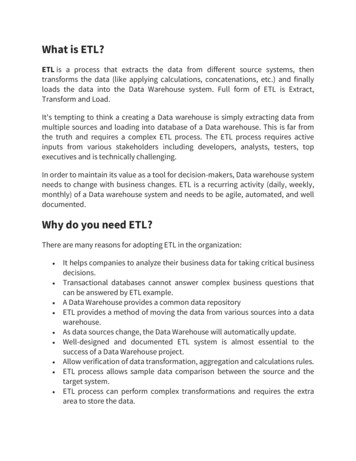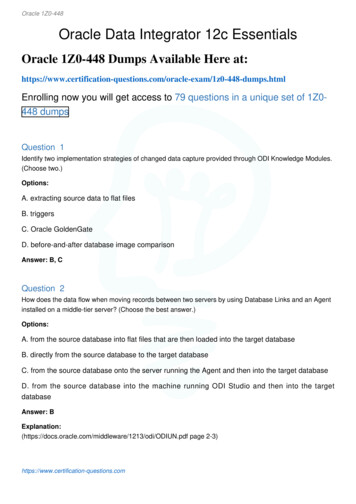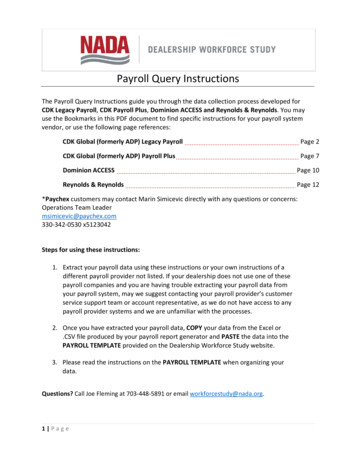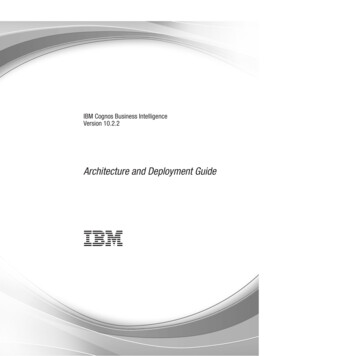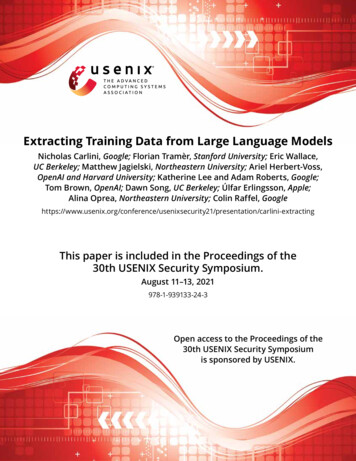
Transcription
Extracting Training Data from Large Language ModelsNicholas Carlini, Google; Florian Tramèr, Stanford University; Eric Wallace,UC Berkeley; Matthew Jagielski, Northeastern University; Ariel Herbert-Voss,OpenAI and Harvard University; Katherine Lee and Adam Roberts, Google;Tom Brown, OpenAI; Dawn Song, UC Berkeley; Úlfar Erlingsson, Apple;Alina Oprea, Northeastern University; Colin Raffel, rity21/presentation/carlini-extractingThis paper is included in the Proceedings of the30th USENIX Security Symposium.August 11–13, 2021978-1-939133-24-3Open access to the Proceedings of the30th USENIX Security Symposiumis sponsored by USENIX.
Extracting Training Data from Large Language ModelsNicholas Carlini1Ariel Herbert-Voss5,6Dawn Song31 Google2 StanfordFlorian Tramèr2Katherine Lee13 UCBerkeleyIntroductionLanguage models (LMs)—statistical models which assign aprobability to a sequence of words—are fundamental to manynatural language processing tasks. Modern neural-networkbased LMs use very large model architectures (e.g., 175 billion parameters [7]) and train on massive datasets (e.g., nearlya terabyte of English text [55]). This scaling increases theability of LMs to generate fluent natural language [53, 74, 76],and also allows them to be applied to a plethora of othertasks [29, 39, 55], even without updating their parameters [7].At the same time, machine learning models are notoriousfor exposing information about their (potentially private) training data—both in general [47, 65] and in the specific case oflanguage models [8, 45]. For instance, for certain models itis known that adversaries can apply membership inferenceattacks [65] to predict whether or not any particular examplewas in the training data.USENIX AssociationTom Brown5Alina Oprea4Colin Raffel14 NortheasternIt has become common to publish large (billion parameter)language models that have been trained on private datasets.This paper demonstrates that in such settings, an adversary canperform a training data extraction attack to recover individualtraining examples by querying the language model.We demonstrate our attack on GPT-2, a language modeltrained on scrapes of the public Internet, and are able to extracthundreds of verbatim text sequences from the model’s trainingdata. These extracted examples include (public) personallyidentifiable information (names, phone numbers, and emailaddresses), IRC conversations, code, and 128-bit UUIDs. Ourattack is possible even though each of the above sequencesare included in just one document in the training data.We comprehensively evaluate our extraction attack to understand the factors that contribute to its success. Worryingly,we find that larger models are more vulnerable than smallermodels. We conclude by drawing lessons and discussing possible safeguards for training large language models.Matthew Jagielski4Adam Roberts1Úlfar Erlingsson7Abstract1Eric Wallace3University5 OpenAI6 Harvard7 ApplePrefixEast Stroudsburg Stroudsburg.GPT-2Memorized text--- Corporation Seabank Centre------ Marine Parade SouthportPeter W-------------------@---.------------.com -- 7 5--- 40-Fax: -- 7 5--- 0--0Figure 1: Our extraction attack. Given query access to aneural network language model, we extract an individual person’s name, email address, phone number, fax number, andphysical address. The example in this figure shows information that is all accurate so we redact it to protect privacy.Such privacy leakage is typically associated with overfitting[75]—when a model’s training error is significantly lowerthan its test error—because overfitting often indicates that amodel has memorized examples from its training set. Indeed,overfitting is a sufficient condition for privacy leakage [72]and many attacks work by exploiting overfitting [65].The association between overfitting and memorization has—erroneously—led many to assume that state-of-the-art LMswill not leak information about their training data. Becausethese models are often trained on massive de-duplicateddatasets only for a single epoch [7, 55], they exhibit littleto no overfitting [53]. Accordingly, the prevailing wisdom hasbeen that “the degree of copying with respect to any givenwork is likely to be, at most, de minimis” [71] and that modelsdo not significantly memorize any particular training example.30th USENIX Security Symposium2633
Contributions. In this work, we demonstrate that large language models memorize and leak individual training examples. In particular, we propose a simple and efficient methodfor extracting verbatim sequences from a language model’straining set using only black-box query access. Our key insight is that, although training examples do not have noticeably lower losses than test examples on average, certain worstcase training examples are indeed memorized.In our attack, we first generate a large, diverse set of highlikelihood samples from the model, using one of three generalpurpose sampling strategies. We then sort each sample usingone of six different metrics that estimate the likelihood ofeach sample using a separate reference model (e.g., anotherLM), and rank highest the samples with an abnormally highlikelihood ratio between the two models.Our attacks directly apply to any language model, includingthose trained on sensitive and non-public data [10,16]. We usethe GPT-2 model [54] released by OpenAI as a representativelanguage model in our experiments. We choose to attackGPT-2 to minimize real-world harm—the GPT-2 model andoriginal training data source are already public.To make our results quantitative, we define a testable definition of memorization. We then generate 1,800 candidatememorized samples, 100 under each of the 3 6 attack configurations, and find that over 600 of them are verbatim samplesfrom the GPT-2 training data (confirmed in collaboration withthe creators of GPT-2). In the best attack configuration, 67%of candidate samples are verbatim training examples. Ourmost obviously-sensitive attack extracts the full name, physical address, email address, phone number, and fax numberof an individual (see Figure 1). We comprehensively analyzeour attack, including studying how model size and string frequency affects memorization, as well as how different attackconfigurations change the types of extracted data.We conclude by discussing numerous practical strategies tomitigate privacy leakage. For example, differentially-privatetraining [1] is theoretically well-founded and guaranteed toproduce private models if applied at an appropriate recordlevel, but it can result in longer training times and typicallydegrades utility. We also make recommendations, such ascarefully de-duplicating documents, that empirically will helpto mitigate memorization but cannot prevent all attacks.2Background & Related WorkTo begin, we introduce the relevant background on large(billion-parameter) neural network-based language models(LMs) as well as data privacy attacks.2.1Language ModelingLanguage models are a fundamental building block of current state-of-the-art natural language processing pipelines[12, 31, 50, 52, 55]. While the unsupervised objectives used263430th USENIX Security Symposiumto train these models vary, one popular choice is a “next-stepprediction” objective [5, 31, 44, 52]. This approach constructsa generative model of the distributionPr(x1 , x2 , . . . , xn ),where x1 , x2 , . . . , xn is a sequence of tokens from a vocabularyV by applying the chain rule of probabilityPr(x1 , x2 , . . . , xn ) Πni 1 Pr(xi x1 , . . . , xi 1 ).State-of-the-art LMs use neural networks to estimate thisprobability distribution. We let fθ (xi x1 , . . . , xi 1 ) denotethe likelihood of token xi when evaluating the neural network f with parameters θ. While recurrent neural networks(RNNs) [26, 44] used to be a common choice for the neural network architecture of LMs, attention-based models [4]have recently replaced RNNs in state-of-the-art models. Inparticular, Transformer LMs [70] consist of a sequence of attention layers and are the current model architecture of choice.Because we believe our results are independent of the exactarchitecture used, we will not describe the Transformer architecture in detail here and instead refer to existing work [3].Training Objective. A language model is trained to maximize the probability of the data in a training set X . In thispaper, each training example is a text document—for example,a specific news article or webpage from the internet. Formally,training involves minimizing the loss functionL (θ) log Πni 1 fθ (xi x1 , . . . , xi 1 )over each training example in the training dataset X . Becauseof this training setup, the “optimal” solution to the task oflanguage modeling is to memorize the answer to the question “what token follows the sequence x1 , . . . , xi 1 ?” for every prefix in the training set. However, state-of-the-art LMsare trained with massive datasets, which causes them to notexhibit significant forms of memorization: empirically, thetraining loss and the test loss are nearly identical [7, 53, 55].Generating Text. A language model can generate newtext (potentially conditioned on some prefix x1 , . . . , xi )by iteratively sampling x̂i 1 fθ (xi 1 x1 , . . . , xi ) and thenfeeding x̂i 1 back into the model to sample x̂i 2 fθ (xi 2 x1 , . . . , x̂i 1 ). This process is repeated until a desiredstopping criterion is reached. Variations of this text generationmethod include deterministically choosing the most-probabletoken rather than sampling (i.e., “greedy” sampling) or settingall but the top-n probabilities to zero and renormalizing theprobabilities before sampling (i.e., top-n sampling1 [18]).GPT-2. Our paper focuses on the GPT variant of Transformer LMs [7,52,54]. Specifically, we demonstrate our training data extraction attacks on GPT-2, a family of LMs that1 Fornotational clarity, we write top-n instead of the more common top-kbecause we will use the constant k for a separate purpose.USENIX Association
were all trained using the same dataset and training algorithm,but with varying model sizes. GPT-2 uses a word-pieces [61]vocabulary with a byte pair encoder [22].GPT-2 XL is the largest model with 1.5 billion parameters.For the remainder of this paper, the “GPT-2” model refersto this 1.5 billion parameter model or, when we specificallyindicate this, its Small and Medium variants with 124 millionand 334 million parameters, respectively.The GPT-2 model family was trained on data scraped fromthe public Internet. The authors collected a dataset by following outbound links from the social media website Reddit. Thewebpages were cleaned of HTML, with only the documenttext retained, and then de-duplicated at the document level.This resulted in a final dataset of 40GB of text data, overwhich the model was trained for approximately 12 epochs.2As a result, GPT-2 does not overfit: the training loss is onlyroughly 10% smaller than the test loss across all model sizes.2.2Training Data PrivacyIt is undesirable for models to remember any details that arespecific to their (potentially private) training data. The fieldof training data privacy develops attacks (to leak training datadetails) and defenses (to prevent leaks).Privacy Attacks. When models are not trained withprivacy-preserving algorithms, they are vulnerable to numerous privacy attacks. The least revealing form of attack is themembership inference attack [28, 47, 65, 67]: given a trainedmodel, an adversary can predict whether or not a particularexample was used to train the model. Separately, model inversion attacks [21] reconstruct representative views of a subsetof examples (e.g., a model inversion attack on a face recognition classifier might recover a fuzzy image of a particularperson that the classifier can recognize).Training data extraction attacks, like model inversion attacks, reconstruct training datapoints. However, training dataextraction attacks aim to reconstruct verbatim training examples and not just representative “fuzzy” examples. This makesthem more dangerous, e.g., they can extract secrets such asverbatim social security numbers or passwords. Training dataextraction attacks have until now been limited to small LMstrained on academic datasets under artificial training setups(e.g., for more epochs than typical) [8, 66, 68, 73], or settingswhere the adversary has a priori knowledge of the secret theywant to extract (e.g., a social security number) [8, 27].Protecting Privacy. An approach to minimizing memorization of training data is to apply differentially-private trainingtechniques [1, 9, 43, 60, 64]. Unfortunately, training modelswith differentially-private mechanisms often reduces accuracy [34] because it causes models to fail to capture the longtails of the data distribution [19,20,67]. Moreover, it increasestraining time, which can further reduce accuracy because current LMs are limited by the cost of training [35, 38, 55]. Asa result, state-of-the-art LMs such as GPT-2 [53], GPT-3 [7],and T5 [55] do not apply these privacy-preserving techniques.3Threat Model & EthicsTraining data extraction attacks are often seen as theoreticalor academic and are thus unlikely to be exploitable in practice[71]. This is justified by the prevailing intuition that privacyleakage is correlated with overfitting [72], and because stateof-the-art LMs are trained on large (near terabyte-sized [7])datasets for a few epochs, they tend to not overfit [53].Our paper demonstrates that training data extraction attacksare practical. To accomplish this, we first precisely definewhat we mean by “memorization”. We then state our threatmodel and our attack objectives. Finally, we discuss the ethicalconsiderations behind these attacks and explain why they arelikely to be a serious threat in the future.3.1Defining Language Model MemorizationThere are many ways to define memorization in languagemodeling. As mentioned earlier, memorization is in manyways an essential component of language models becausethe training objective is to assign high overall likelihood tothe training dataset. LMs must, for example, “memorize” thecorrect spelling of individual words.Indeed, there is a research direction that analyzes neuralnetworks as repositories of (memorized) knowledge [51, 59].For example, when GPT-2 is prompted to complete the sentence “My address is 1 Main Street, San Francisco CA”, itgenerates “94107”: a correct zip code for San Francisco, CA.While this is clearly memorization in some abstract form,weaim to formalize our definition of memorization in order torestrict it to cases that we might consider “unintended” [8].3.1.1Eidetic Memorization of TextWe define eidetic memorization as a particular type of memorization.3 Informally, eidetic memorization is data that hasbeen memorized by a model despite only appearing in a smallset of training instances. The fewer training samples that contain the data, the stronger the eidetic memorization is.To formalize this notion, we first define what it means fora model to have knowledge of a string s. Our definition isloosely inspired by knowledge definitions in interactive proofsystems [24]: a model fθ knows a string s if s can be extractedby interacting with the model. More precisely, we focus onblack-box interactions where the model generates s as themost likely continuation when prompted with some prefix c:3 Eidetic2 Personalcommunication with the GPT-2 authors.USENIX Associationmemory (more commonly called photographic memory) is theability to recall information after seeing it only once.30th USENIX Security Symposium2635
Definition 1 (Model Knowledge Extraction) A string s isextractable4 from an LM fθ if there exists a prefix c such that:s arg max fθ (s0 c)s0 : s0 NWe abuse notation slightly here to denote by fθ (s0 c) thelikelihood of an entire sequence s0 . Since computing the mostlikely sequence s is intractable for large N, the arg max inDefinition 1 can be replaced by an appropriate sampling strategy (e.g., greedy sampling) that reflects the way in which themodel fθ generates text in practical applications. We thendefine eidetic memorization as follows:Definition 2 (k-Eidetic Memorization) A string s is keidetic memorized (for k 1) by an LM fθ if s is extractablefrom fθ and s appears in at most k examples in the trainingdata X: {x X : s x} k.Key to this definition is what “examples” means. For GPT2, each webpage is used (in its entirety) as one training example. Since this definition counts the number of distinct trainingexamples containing a given string, and not the total numberof times the string occurs, a string may appear multiple timeson one page while still counting as k 1 memorization.This definition allows us to define memorization as a spectrum. While there is no definitive value of k at which we mightsay that memorization is unintentional and potentially harmful, smaller values are more likely to be so. For any given k,memorizing longer strings is also “worse” than shorter strings,although our definition omits this distinction for simplicity.For example, under this definition, memorizing the correctspellings of one particular word is not severe if the word occurs in many training examples (i.e., k is large). Memorizingthe zip code of a particular city might be eidetic memorization,depending on whether the city was mentioned in many training examples (e.g., webpages) or just a few. Referring back toFigure 1, memorizing an individual person’s name and phonenumber clearly (informally) violates privacy expectations, andalso satisfies our formal definition: it is contained in just afew documents on the Internet—and hence the training data.3.2Threat ModelAdversary’s Capabilities. We consider an adversary whohas black-box input-output access to a language model. Thisallows the adversary to compute the probability of arbitrarysequences fθ (x1 , . . . , xn ), and as a result allows the adversaryto obtain next-word predictions, but it does not allow theadversary to inspect individual weights or hidden states (e.g.,attention vectors) of the language model.4 Thisdefinition admits pathological corner cases. For example, manyLMs when when prompted with “Repeat the following sentence: .” willdo so correctly. This allows any string to be “known” under our definition.Simple refinements of this definition do not solve the issue, as LMs can alsobe asked to, for example, down-case a particular sentence. We avoid thesepathological cases by prompting LMs only with short prefixes.263630th USENIX Security SymposiumThis threat model is highly realistic as many LMs areavailable through black-box APIs. For example, the GPT3 model [7] created by OpenAI is available through black-boxAPI access. Auto-complete models trained on actual user datahave also been made public, although they reportedly useprivacy-protection measures during training [10].Adversary’s Objective. The adversary’s objective is to extract memorized training data from the model. The strengthof an attack is measured by how private (formalized as beingk-eidetic memorized) a particular example is. Stronger attacksextract more examples in total (both more total sequences,and longer sequences) and examples with lower values of k.We do not aim to extract targeted pieces of training data, butrather indiscriminately extract training data. While targetedattacks have the potential to be more adversarially harmful,our goal is to study the ability of LMs to memorize datagenerally, not to create an attack that can be operationalizedby real adversaries to target specific users.Attack Target. We select GPT-2 [54] as a representativeLM to study for our attacks. GPT-2 is nearly a perfect target.First, from an ethical standpoint, the model and data are public,and so any memorized data that we extract is already public.5Second, from a research standpoint, the dataset (despite beingcollected from public sources) was never actually releasedby OpenAI. Thus, it is not possible for us to unintentionally“cheat” and develop attacks that make use of knowledge ofthe GPT-2 training dataset.3.3Risks of Training Data ExtractionTraining data extraction attacks present numerous privacyrisks. From an ethical standpoint, most of these risks are mitigated in our paper because we attack GPT-2, whose trainingdata is public. However, since our attacks would apply to anyLM, we also discuss potential consequences of future attackson models that may be trained on private data.Data Secrecy. The most direct form of privacy leakage occurs when data is extracted from a model that was trainedon confidential or private data. For example, GMail’s autocomplete model [10] is trained on private text communications between users, so the extraction of unique snippets oftraining data would break data secrecy.Contextual Integrity of Data. The above privacy threatcorresponds to a narrow view of data privacy as data secrecy.5 Since the training data is sourced from the public Web, all the outputsof our extraction attacks can also be found via Internet searches. Indeed,to evaluate whether we have found memorized content, we search for thecontent on the Internet and are able to find these examples relatively easily.USENIX Association
A broader view of the privacy risks posed by data extraction stems from the framework of data privacy as contextualintegrity [48]. That is, data memorization is a privacy infringement if it causes data to be used outside of its intendedcontext. An example violation of contextual integrity is shownin Figure 1. This individual’s name, address, email, and phonenumber are not secret—they were shared online in a specificcontext of intended use (as contact information for a softwareproject)—but are reproduced by the LM in a separate context.Due to failures such as these, user-facing applications that useLMs may inadvertently emit data in inappropriate contexts,e.g., a dialogue system may emit a user’s phone number inresponse to another user’s query.Just as responsible disclosure still causes some (limited)harm, we believe that the benefits of publicizing these attacksoutweigh the potential harms. Further, to make our attackspublic, we must necessarily reveal some sensitive information.We contacted the individual whose information is partiallyshown in Figure 1 to disclose this fact to them in advanceand received permission to use this example. Our researchfindings have also been disclosed to OpenAI.Unfortunately, we cannot hope to contact all researcherswho train large LMs in advance of our publication. We thushope that this publication will spark further discussions on theethics of memorization and extraction among other companiesand research teams that train large LMs [2, 36, 55, 63].Small-k Eidetic Risks. We nevertheless focus on k-eideticmemorization with a small k value because it makes extractionattacks more impactful.While there are cases where large-kmemorization may still matter (for example, a company mayrefer to the name of an upcoming product multiple times inprivate—and even though it is discussed often the name itselfmay still be sensitive) we study the small-k case.Moreover, note that although we frame our paper as an “attack”, LMs will output memorized data even in the absence ofan explicit adversary. We treat LMs as black-box generativefunctions, and the memorized content that we extract can begenerated through honest interaction with the LM. Indeed, wehave even discovered at least one memorized training example among the 1,000 GPT-3 samples that OpenAI originallyreleased in its official repository [49].4We begin with a simple strawman baseline for extractingtraining data from a language model in a two-step procedure. Generate text. We generate a large quantity of data byunconditionally sampling from the model (Section 4.1). Predict which outputs contain memorized text. Wenext remove the generated samples that are unlikely tocontain memorized text using a membership inferenceattack (Section 4.2).These two steps correspond directly to extracting modelknowledge (Definition 1), and then predicting which stringsmight be k-eidetic memorization (Definition 2).4.13.4Ethical ConsiderationsIn this paper, we will discuss and carefully examine specificmemorized content that we find in our extraction attacks. Thisraises ethical considerations as some of the data that we extract contains information about individual users.As previously mentioned, we minimize ethical concerns byusing data that is already public. We attack the GPT-2 model,which is available online. Moreover, the GPT-2 training datawas collected from the public Internet [54], and is in principleavailable to anyone who performs the same (documented)collection process as OpenAI, e.g., see [23].However, there are still ethical concerns even though themodel and data are public. It is possible—and indeed wefind it is the case—that we might extract personal information for individuals from the training data. For example, asshown in Figure 1, we recovered a person’s full name, address, and phone number. In this paper, whenever we succeedin extracting personally-identifying information (usernames,phone numbers, etc.) we partially mask out this content withthe token. We are aware of the fact that this does notprovide complete mediation: disclosing that the vulnerabilityexists allows a malicious actor to perform these attacks ontheir own to recover this personal information.USENIX AssociationInitial Training Data Extraction AttackInitial Text Generation SchemeTo generate text, we initialize the language model with a onetoken prompt containing a special start-of-sentence token andthen repeatedly sample tokens in an autoregressive fashionfrom the model (see Section 2.1 for background). We hopethat by sampling according to the model’s assigned likelihood,we will sample sequences that the model considers “highlylikely”, and that likely sequences correspond to memorizedtext. Concretely, we sample exactly 256 tokens for each trialusing the top-n strategy from Section 2.1 with n 40.4.2Initial Membership InferenceGiven a set of samples from the model, the problem of trainingdata extraction reduces to one of membership inference: predict whether each sample was present in the training data [65].In their most basic form, past membership inference attacksrely on the observation that models tend to assign higher confidence to examples that are present in the training data [46].Therefore, a potentially high-precision membership inferenceclassifier is to simply choose examples that are assigned thehighest likelihood by the model.Since LMs are probabilistic generative models, we followprior work [8] and use a natural likelihood measure: the per-30th USENIX Security Symposium2637
plexity of a sequence measures how well the LM “predicts”the tokens in that sequence. Concretely, given a sequence oftokens x1 , . . . , xn , the perplexity is defined as!1 nP exp log fθ (xi x1 , . . . , xi 1 )n i 1That is, if the perplexity is low, then the model is not very“surprised” by the sequence and has assigned on average ahigh probability to each subsequent token in the sequence.4.3Initial Extraction ResultsWe generate 200,000 samples using the largest version ofthe GPT-2 model (XL, 1558M parameters) following the textgeneration scheme described in Section 4.1. We then sortthese samples according to the model’s perplexity measureand investigate those with the lowest perplexity.This simple baseline extraction attack can find a wide variety of memorized content. For example, GPT-2 memorizesthe entire text of the MIT public license, as well as the userguidelines of Vaughn Live, an online streaming site. Whilethis is “memorization”, it is only k-eidetic memorization fora large value of k—these licenses occur thousands of times.The most interesting (but still not eidetic memorization forlow values of k) examples include the memorization of popular individuals’ Twitter handles or email addresses (omittedto preserve user privacy). In fact, all memorized content weidentify in this baseline setting is likely to have appeared inthe training dataset many times.This initial approach has two key weaknesses that we canidentify. First, our sampling scheme tends to produce a lowdiversity of outputs. For example, out of the 200,000 sampleswe generated, several hundred are duplicates of the memorized user guidelines of Vaughn Live.Second, our baseline membership inference strategy suffersfrom a large number of false positives, i.e., content that isassigned high likelihood but is not memorized. The majorityof these false positive samples contain “repeated” strings (e.g.,the same phrase repeated multiple times). Despite such textbeing highly unlikely, large LMs often incorrectly assign highlikelihood to such repetitive sequences [30].5Improved Training Data Extraction AttackThe proof-of-concept attack presented in the previous sectionhas low precision (high-likelihood samples are not always inthe training data) and low recall (it identifies no k-memorizedcontent for low k). Here, we improve the attack by incorporating better methods for sampling from the model (Section 5.1)and membership inference (Section 5.2).263830th USENIX Security Symposium5.1Improved Text Generation SchemesThe first step in our attack is to randomly sample from the language model. Above, we used top-n sampling and conditionedthe LM on the start-of-sequence token as input. This strategyhas clear limitations [32]: it will only generate sequences thatare likely from beginning to end. As a result, top-n samplingfrom the model will cause it to generate the same (or similar)examples several times. Below we describe two alternativetechniques for generating more diverse samples from the LM.5.1.1Sampling With A Decaying TemperatureAs described in Section 2.1, an LM outputs the probability ofthe next token given the prior tokens Pr(xi x1 ,
(billion-parameter) neural network-based language models (LMs) as well as data privacy attacks. 2.1 Language Modeling Language models are a fundamental building block of cur-rent state-of-the-art natural language processing pipelines [12,31,50,52,55]. While the unsupervised objectives used to train these
